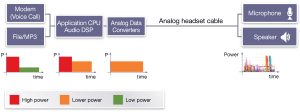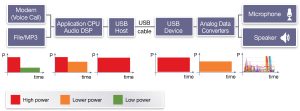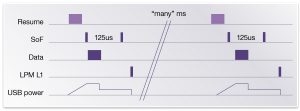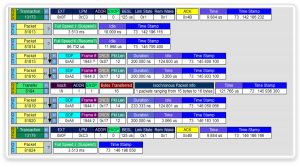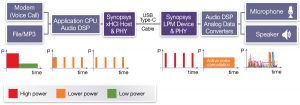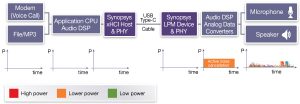Reducing the power consumption of USB Type-C digital headsets
Thinner phones are going to need new connectors. Many designers are considering USB Type-C, and the related Audio Device Class 3.0 specification (ADC 3.0), for use in high-quality digital headsets.
The ¼in phone jack was invented more than 100 years ago to connect people who were using a new invention called ‘the telephone’. Today, the 3.5mm modern equivalent of that enormous jack has become ubiquitous, but mobile phone designers are looking for a new approach to audio connectivity so they can make handsets even slimmer.
Designers are considering many proprietary and standard USB audio protocols. One of these is the recent USB Audio Device Class (ADC) 3.0 specification, which is meant to enable industry to standardize on a protocol and so speed up consumer adoption. ADC 3.0 enables high-quality digital headsets with a local digital signal processor (DSP) to handle features such as adaptive noise cancelling, user-defined equalization, and hot-word detection (that is, spotting phrases such as ‘OK Google’ or ‘Alexa…’). The specification also defines power-saving strategies that should help it become the standard audio protocol for mobile phones that use the USB Type-C connector.
Analog headset power
Analog audio solutions, typically using that 3.5mm jack, generally don’t use a lot of power. Figure 1 shows that audio processing for voice calls or MP3 playback is typically bursty, which allows functional blocks to enter lower-power modes between bursts of activity. Some manufacturers have implemented even more optimized power profiles for audio playback than shown.
Figure 1 Power profiles for mobile phone with analog headset (Source: Synopsys)
The USB audio power challenge
Unlike analog headsets, USB audio headsets use isochronous transfers that provide the guaranteed bandwidth necessary for audio streams – at the cost of greater power consumption. The power profiles to support a USB headset are shown in Figure 2. The system has two more functional blocks (USB Host and USB Device) than the analog approach shown above. The additional blocks operate continuously in high-power mode, and some implementations even require the application CPU to stay in high-power mode continuously to feed the USB host with audio bursts to the speaker and process samples from the microphone.
Figure 2 Power profiles for mobile phone with legacy USB audio headset (Source: Synopsys)
The additional power required to support legacy USB audio is of little concern for a headset used with a plugged-in desktop or laptop with a high-capacity battery. However, legacy USB audio cannot replace the 3.5mm phone jack in mobile phones and other portable, battery-powered products, because it would drain the battery too quickly.
Saving power in legacy USB audio implementations
Isochronous transfers for legacy USB audio occur every 1ms for Full Speed USB. The bus is idle between transfers, but cannot enter Suspend L2. The USB 2.0 Link Power Management specification defined a new power state (LPM L1 Suspend mode) for High Speed USB, which, when combined with High Speed USB bursting, saves power. Figure 3 shows how the new audio specification saves power as a function of time.
Figure 3 Concept for audio bursting and LPM L1 for power saving (Source: Synopsys)
Proving the ADC 3.0 concept
The ADC 3.0 specification uses this LPM L1 based power-saving strategy, even though LPM L1 is not widely used nor supported today. A successful proof-of-concept of this approach was built using Synopsys DesignWare USB IP and is shown in Figure 4, as follows:
- Transaction 13713 shows the host sending the LPM request, which is accepted by the device.
- Packet 81813 shows the bus in the LPM L1 suspend power state for 3.5ms.
- Packet 81814 shows the host resuming the device. Resume signaling lasts 86us in this example, and this value is configurable to account for different device wake-up times.
- Packets 81815 and 81816 are two timer ticks.
- Transfer 6194 shows the host reading isochronous data from the device.
- Packets 81819 and 81820 are two timer ticks, but the last timer tick is not needed and can be removed in future implementations.
- Finally, transaction 13175 shows a new host LPM L1 request and acknowledgement, before packet 81824 shows the bus in LPM L1 Suspend for another 3.5ms as the cycle repeats.
Figure 4 Proof of concept for LPM L1 power saving in USB audio (Source: Synopsys)
Saving power in USB ADC 3.0 implementations
The resulting power profiles, based on this proof of concept, are shown in Figure 5. This system spends 87.8% (3.513ms of a 4ms service interval) in the LPM L1 Suspend state. PHY power consumption is important to consider alone, as it is typically much higher than controller power consumption. The power consumed in the LPM L1 state is typically less than 1% of active or idle power, and using LPM L1 can also result in PHY power savings of 86%. This enables USB Audio Device Class 3.0 USB headset solutions whose power consumption is competitive with that of legacy analog headset solutions.
Figure 5 Power profiles for mobile phone with USB Audio Device Class 3.0 headset (Source: Synopsys)
Designers can save power by putting the CPU and/or DSP system in deep sleep between USB bursts. It is also possible to schedule multiple audio bursts in advance, to save more power by leaving the CPU and/or DSP subsystem in deep sleep for longer – at the expense of greater audio latency. The acceptability of this approach will depend on the application.
Additional ADC 3.0 features
The audio quality of headsets with analog connections is limited by the choice of ADC, DAC and audio processing in the phone, tablet, etc. Device makers trade off cost, power and quality and their choices, once made, cannot be circumvented. However, when device makers implement ADC 3.0, there are no ADCs or DACs in the device. Device makers can concentrate on reducing power, since they no longer have much influence over features, cost and audio quality.
ADC 3.0 headsets support up to 24bit/192kHz audio format for high-quality audio. Headset makers can add a local DSP to implement features such as microphone beam-forming, and active noise cancellation (see Figures 5 and 6).
Figure 6 Power profiles for active noise cancellation in ADC 3.0 headset (Source: Synopsys)
It is also possible to use ADC 3.0 implementations of USB audio to enable the design of multipurpose headsets. For example, manufacturers could design a combined wireless Bluetooth and wired USB headset that charges the battery when connected to a phone or USB charger: Bluetooth is used for convenience and phone calls, USB for listening to music, watching videos or just cancelling ambient noise.
Synopsys USB IP support for ADC 3.0
To implement ADC 3.0 in low-power products such as phones, tablets or laptops, designers will need a host controller that is compliant with the ADC 3.0 specification and which can control Link Power Management status. Synopsys’ DesignWare xHCI USB 1.1 controller was used for the LPM L1 proof of concept discussed here. A Synopsys PHY, available in mature, low-power processes for headsets and in advanced process nodes for hosts, also supports LPM L1 using proprietary extensions to the PHY/controller interface.
Conclusions
Audio connectors have been getting steadily smaller since the 1/4in jack was invented for telephones over a century ago. Just as it must have been hard to visualize the need for a 3.5mm jack for mobile phones then, it was equally difficult to imagine that the 3.5mm jack would itself eventually need replacing. That time has now arrived, and well thought-through implementations of the USB Audio Device Class 3.0 specification will enable the development of power-efficient, feature-rich, cost and quality optimized digital headsets that use a USB Type-C connector to replace the ubiquitous 3.5mm jack.
Author
Morten Christiansen is a technical marketing manager at Synopsys.
